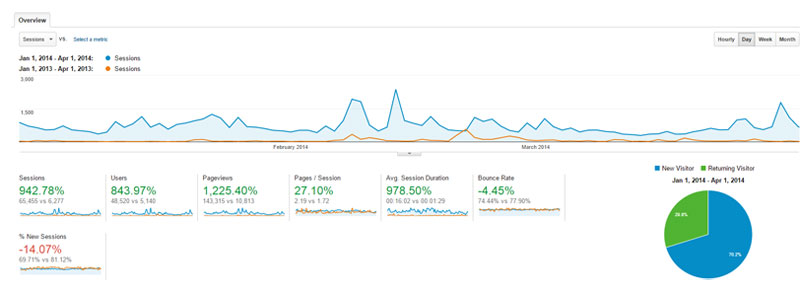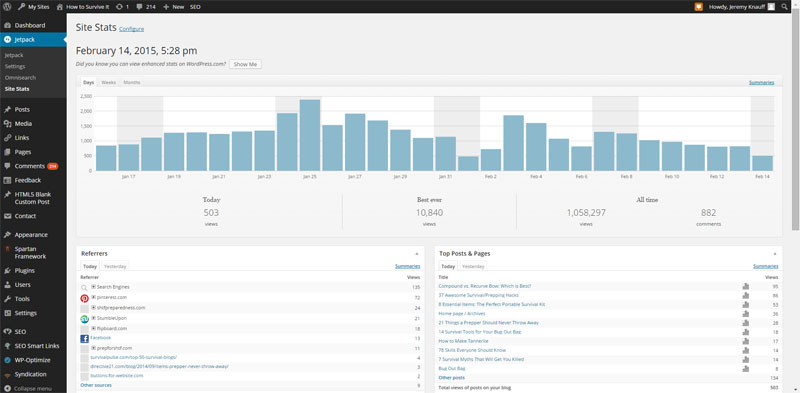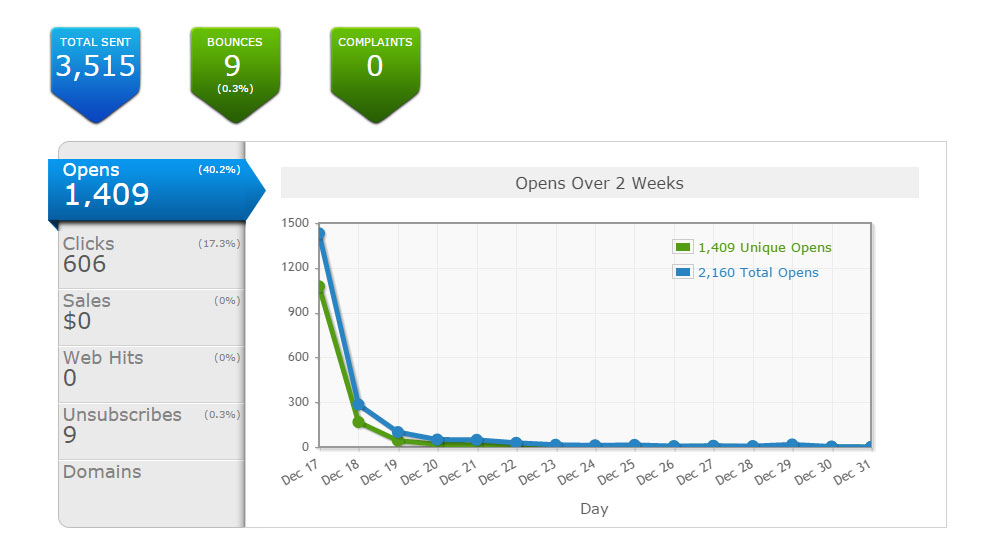Don’t you hate wasting time and money on marketing that didn’t work out? The most common reason this happens is because business owners fail to plan. When your “marketing plan” consists of trying things out to see what happens, it’s no wonder you don’t get the results you want.
Most business owners start a marketing campaign without defining a clear goal, and then they execute it without any real plan. That’s a recipe for failure.
Without a clearly defined goal, how do you know when you’ve achieved success? Without a plan, how do you know you’re on the right path? And without a timeline, how do you measure your progress?
It’s easy to create a successful marketing campaign by investing a little work upfront to outline exactly what you want to achieve, how you’ll do it, how long it should take, and how much you’re prepared to spend.
Set specific and quantifiable goals
Imagine yourself in a ship; would you leave the harbor and head out to sea with no destination in mind? Of course not, that would be stupid and dangerous. If you don’t know where you’re going, you can’t plot a course or pack appropriate provisions like food and water. You would almost certainly die.

Marketing isn’t much different—without setting goals, you will almost certainly fail. I know, it’s not as dramatic as being lost at sea and slowly starving to death, but it’s still worth avoiding.
Few people set goals, and even fewer set them properly. We have a particular client who loves to set what he thinks are goals, but they’re really just fluffy dreams. For example, during meetings, he routinely proclaims that “we want to be the top company in xyz industry,” but what does that even mean? The biggest? The most profitable? The one your mom likes the best?
In order to truly be a goal, it must meet two criteria:
- specific
- quantifiable
Some examples of specific and quantifiable goals could be:
- Generate $1 million in revenue
- Rank #1 for the term “guest post”
- Build email list of 40,000 subscribers
It’s easy to measure the examples above. You either achieved them or you didn’t.
Where a lot of people go wrong is setting goals that can’t be quantified. An example of a goal that can’t be quantified could be to become the best interior designer in your city. How do you measure that? Are you looking at the number of awards? Revenue? Landing a particular client?
Develop a detailed plan and timeline
Once you have set a goals, you can work backwards from there to develop a realistic plan and timeline to achieve them.
A lot of business owners ignore this step and just try whatever seems like a good idea at the time. We have a name for that in the marketing world: guess work.

Let’s look at the goal of building an email list of 40,000 subscribers as an example. A realistic plan, starting from the goal, working backwards, might look like this:
Determine Current Conversion Rate
(daily subscribers / daily traffic)
Example: Your website receives 2,000 visitors per day, and 60 of them sign up for your newsletter.
60 / 2,000 = 0.03
So you have a conversion rate of 3%
Estimate New Subscribers Over the Next 12 Months
(daily subscribers x time span)
Example: 6o people subscribe to your newsletter per day, and you want to estimate how many will subscribe over the next 12 months.
60 x 365 = 21,900
Calculate Difference from Subscriber Goal
(new subscriber goal – estimated new subscribers from existing traffic)
Example: Subtract your estimated 21,900 new subscribers from existing traffic from your new subscriber goal of 40,000.
40,000 – 21,900 = 18,100
Determine Traffic Increase Required to Reach Subscriber Goal
(difference / conversion rate)
Example: Divide the difference (18,100) by your conversion rate of 3% (.03) to determine how much additional traffic you’ll need over the next 12 months to reach your goal.
18,100 / .03 = 603,333
Break Down the Details
(traffic increase / 365)
Example: Divide the traffic increase required by 365 to break it down to the number of new visitors you will have to acquire each day (on top of your existing traffic) to reach your goal.
603,333 / 365 = 1,653
Give Yourself Some Room
Both your conversion rate and traffic will fluctuate over time, so it’s best to aim beyond your goal. Don’t go overboard, but don’t play it too conservative, either. I would pad your traffic increase by 10-15% to ensure you hit your goal.
1,653 x 1.1 = 1,818
Ignore opportunities that don’t directly contribute to your plan
We have a particular client who is always eager to try new things—sometimes too eager, because he always wants to run in eight directions at once.
Motivation can be a good thing, but not when it detracts from your goals.

Let’s say that you’ve developed a content marketing campaign. This will require you to compile a list of blogs that might be receptive to publishing your guest posts, pitching your proposed titles to the blog owners, writing articles that appeal both to your market and the publishers audience, and sending one to each blog that agreed to publish them. This is a massive undertaking, and it’s not uncommon to spend hours pitching dozens of blogs before you get a single yes.
Most people stop or shift focus because they get worried when they don’t see results immediately. I hate to be the bearer of bad news, but 99% of the time, you won’t see results immediately. Hell, most of the time, you won’t even see results soon. Results will come incrementally over time, but only if you stick it out while everyone else is giving up.
Successful companies are successful because they do what others don’t. They put in the hard work until they see results. If it happened quickly and easily, everyone would be successful.
Back to your hypothetical content marketing campaign…after a few weeks, it’s starting to produce results, but not as quickly as you’d like. Then you see a really cool newsletter in your inbox and think it would be a great idea to launch your own. You think it seems like a great marketing channel, and it might even take off faster than content marketing, so you decide to give it a try.
That means you’ll have to divert resources from your content marketing campaign to your email marketing campaign. With reduced resources directed to your content marketing campaign, it will now take even longer to produce the results you’re looking for, and since you can’t direct your full focus to your new email campaign, it will fail to gain traction at all. Email marketing is a great tactic, but in this case, a bad idea because you’re spreading yourself too thin and damaging both campaigns.
Marketing, like investing, works on compounding. Early in the process, gains will be slow and difficult, but as you build momentum, your gains will multiply exponentially. As you achieve greater exposure, you develop leverage that will help you produce results from future marketing efforts more quickly and easily.
Spreading resources before reaching your goal will increase time and cost, waste money, and reduce ROI. On the other hand, focusing on one goal until you reach it will get you there faster with less effort and cost while improving ROI.
Set one marketing goal and pour all of your resources into accomplishing it until you’ve achieved success. If you aren’t happy with the performance of that particular campaign, you should consider eliminating it entirely and redirecting your resources rather than reducing it.
Set a budget
When you throw a little money here and there at a campaign, it adds up a lot more quickly than if you set a budget based on hard data.
You need to know two things:
- How much are you willing to invest in your campaign?
- The cost to acquire each customer?
The amount you’re willing to invest in your campaign depends mostly on your bank account, and each campaign will vary based on scale and service. For example, you could run Facebook or Google ads for as little as $30/month, while search engine optimization or content marketing from a reputable provider might start at the $1,000/month range. (Though it can easily climb into tens of thousands per month depending on the scale of your campaign.)
The amount you’re willing to spend to acquire each customer can be a little more complex. Larger companies with established cash flow can afford to break even or even acquire customers at a loss because they know they’ll make up the difference on future orders, but most companies should aim to turn at least a little profit on each customer from the very first order. Here’s the kicker—you won’t know the per customer cost until you run your campaign for a while because conversions will vary depending on your offer and traffic source.
Determine Cost Per Customer
(ad cost / orders)
Example: You spend $200 on Facebook ads, which results in 15 orders.
$200 / 15 = $13.33
Determine if Cost Per Customer is Acceptable
This is a judgement call—what are you willing to spend to acquire a single customer? If you only have a $15 ebook available to sell, this might not be the idea marketing channel for you, on the other hand, if you’re selling an online training course for $199, it would be a great channel based on these numbers. Evaluate your profit per sale, but also look at potential upsells and future opportunities. Maybe they buy one product today, but after seeing the quality, go on to buy every other product you offer. Don’t underestimate the value of adding them to your mailing list—that gives you the opportunity to continue to market to them in the future.
Test everything
The best marketers turn testing into an art form, split-testing email subject lines, ad headlines, landing pages, prices, mobile vs. desktop…pretty much any variable that can be tested.
They get the best results because they don’t let their ego get in the way.
I’ve been marketing for nearly two decades and I still have campaigns that don’t perform as well as I expected and campaigns that blow my expectations out of the water. By this point, I’m wise enough to realize I don’t know everything, so I test multiple variations of every campaign we run.
That shows me exactly what performs best with the target market—there is no guess work. I prove what works on a small scale, and avoid wasting money. Here is an example of that process:
I invest a couple hundred dollars to test several ads and landing pages.
I select the top=performing 3-5 ad/landing page combinations.
I direct the full daily budget to those ad/landing page combinations.
I monitor conversion rates to ensure the ad/landing page combinations continue to perform at scale. If necessary, I make ongoing improvements.
Don’t stop there though, you can test other factors, such as time on site, what contributed to purchasing multiple products, or who went on to sign up for your newsletter or write a review. The possibilities are endless, it’s just a matter of deciding what data is important to your sales funnel.
I highly recommend Google Analytics and Jetpack to track what visitors are doing while on your site, but full integration with your eCommerce, newsletter subscription, and other specialized applications might require additional steps beyond the basic installation.


Third-party services, like Aweber for email marketing, provide outstanding split-testing and tracking support. In the example below, Aweber shows you exactly how many emails were sent, opened, and bounced, how many people complained (claiming it was spam), how many unsubscribed, how many links were clicked, and although it’s not tracked in this example, sales resulted from your email campaign.

